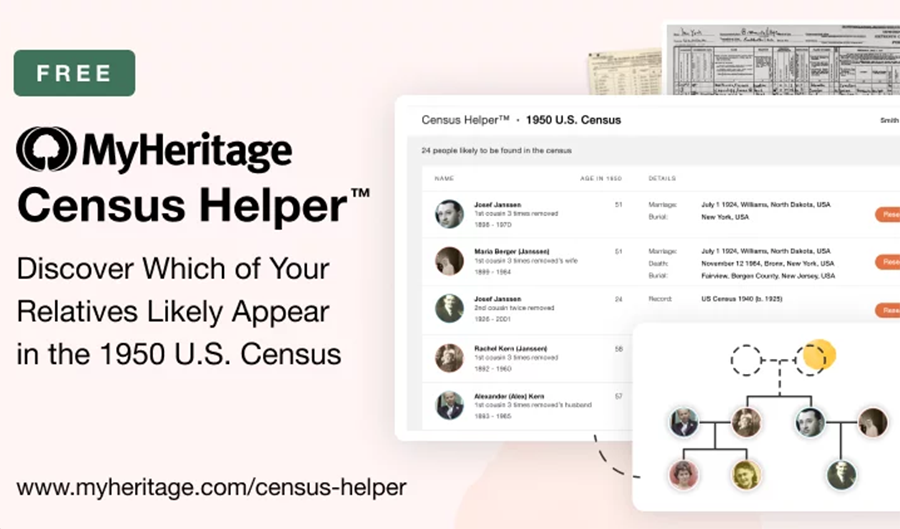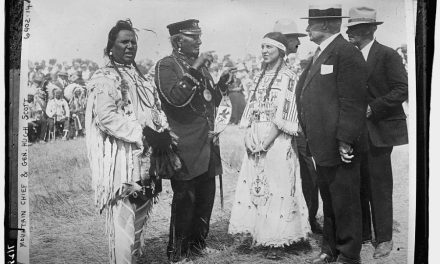MyHeritage have introduced a new free tool on their website: the Census Helper™. This is a feature that scans your family tree and compiles a list of your relatives who are very likely to be found in the 1950 U.S. census.
The tool is available for all MyHeritage users. If you are not using MyHeritage yet, you can join and bring your tree over (via GEDCOM import) and benefit from this useful tool, which will save you time and give direction to your research.
The 1950 US Census is now searchable online and many genealogists starting to research it with great enthusiasm. Federal U.S. Census records are released once a decade, and the 1950 records reveal a wealth of information about ancestors living on US soil (and some US citizens serving abroad) after the conclusion of World War II.
You can prepare for your census research project by creating a list with the Census Helper™ to focus your research. Armed with this list, you’ll know exactly which family members to find in the newly released 1950 census records. Next to each relative the Census Helper™ provides a convenient button to research that person in the census in one click. The names of people you’ve already researched will be indicated, as will the names for whom automatic Record Matches were found in the census. This makes the Census Helper™ a comprehensive research tool that allows you to squeeze every bit of valuable information out of the census without missing a drop.
How does it work?
When you access the Census Helper™ for the first time, it scans your family tree on MyHeritage to identify all people who are most likely to be found in the 1950 U.S. Census. It then saves the results to allow you to access them very quickly at any point afterwards. The list of results can be easily exported for use outside of MyHeritage.
The purpose of the Census Helper™ is to find the people in your family tree who were alive in April 1950 and living in the U.S. Because the 1950 U.S. census was a nationwide survey, almost everyone living in the U.S. at the time was enumerated. This means you can find valuable information about those people in the 1950 U.S. census.
To find the relevant relatives, the Census Helper™ rules out those who missed being included in the census: they were either born after April 1950, or died before that month. When dates for an individual are missing in the family tree, it deduces them from other relatives. For example, an undated individual who fathered a child in 1840, will not appear in the 1950 census. Once it determines that a certain individual was alive in 1950, it searches for evidence that they were in the United States at the time, by analyzing place information entered for life events in the family tree, such as birth, baptism, residence, marriage, death, and burial. When absent, it deduces this from events of relatives. For example, if a person’s parents were married in the U.S. in 1930, it is quite likely that this person was in fact in the U.S. in 1950, even if no birth or residence information is available for them in the tree.
Additional cues used by the Census Helper™ are matches to other U.S. collections; for example, if an individual has a Record Match to the 1940 U.S. census collection on MyHeritage, or to the Social Security Death Index, evidence increases for their presence in the U.S. While such logic may sound excessive for our American users with a majority of relatives who lived in the U.S., it becomes very valuable for the millions of non-American users on MyHeritage, who have some relatives in the U.S. but they are a minority in their family. Like sorting the wheat from the chaff, the Census Helper™ will easily find them.
Based on this analysis, Census Helper™ generates a list for you with the people most likely to be found in the 1950 U.S. Census.
Click “Show lower-confidence results” to also show people who were likely alive in 1950, but for whom we found no evidence that they were in the United States at the time. Although those people are less likely to be found in the 1950 U.S. Census, there is still a chance that they might be.
You can later revert and choose to hide the lower-confidence results again from the list.
If there is information available indicating that certain individuals were not alive in 1950 or not living in the United States at the time, they will not be included in either list.




